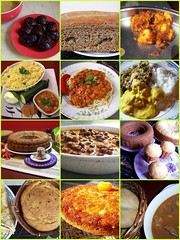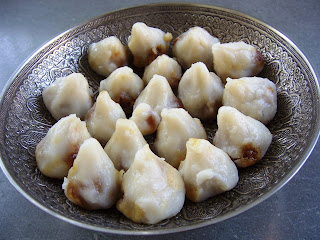
Haven't baked bread for a long long time now though I have been itching to get into the kitchen for a spot of baking. Oh the joys of full time work! It's worse when you know one of your birthday gifts was a book on breads by Sara Lewis and you have been using it as bedtime reading, drooling over the pics instead of sinking your teeth into one of them!
Well, though I had a very long Saturday (AGAIN!) I was determined to bake bread. So, broke out the yeast and set to work. The book had some excellent recipes for flavoured breads and I loved the Spiced Potato and Onion bread as well as the Olive and Tomato Tear and Share Bread. So what does this Gemini do when faced with making a decision - combine the recipes and modify them of course! :)
I didn't have time to boil the potatoes since it was already 7 pm. So I decided to use only the fennel and cumin from that recipe and stick to the olive bread for the most part. Since I didn't have any sun dried tomatoes at home, I decided to use feta cheese instead. I know, I know - bear with me - it gets better, I promise. Then to stir things up some more, I fried some chopped onions with the fennel and cumin seeds and kneaded it into the bread and replaced two thirds of the flour with whole wheat flour.
I was a bit worried after this whether the bread would even rise with the different proportions I had used, but I needn't have worried; the flour didn't know about my penchant for experimentation. It doubled beautifully the first time and when I added the olives and feta cheese and kept it for the second proofing, it rose again.
I baked it for 25 minutes and then covered it with foil to prevent it from browning too much and continued baking for another five minutes. The crust was beautiful and the insides were nice and soft. The flavours were really nice - the fennel and the feta cheese being a great combination!
I an sending this to the 3rd World Bread Day being hosted over at Zorro's in celebration of World Bread Day '08 which falls on October 16th this year.
The original World Bread Day - an event created by UIB International Union of Bakers and Bakers-Confectioners - wants to provide an opportunity to talk about bread and bakers, to find out about their history, their importance as well as their future.
Olive and Feta Cheese Spiced Rustic Bread
(Adapted from The Bread Book by Sara Lewis)
(Adapted from The Bread Book by Sara Lewis)

Whole Wheat flour - 3 cups
Refined flour - 1 cup and upto half a cup more if needed
Active dried yeast - 2 1/2 tsp
1.5 cups water
1 tsp sugar
3/4 tsp salt
2 tbsp olive oil
Chopped Olives - 1/2 cup
Feta Cheese - 1/2 cup crumbled
1 big onion chopped fine
1 tsp fennel seeds
1 tsp cumin seeds
Chilli flakes - 1 tsp
1 tsp oil
1.Warm the water and mix in the sugar and yeast and leave for about 15 minutes till it froths and bubbles.
2.Heat the oil in a pan, add the cumin and fennel seeds and when they crackle, add the onions and chilli flakes and fry on low for 5 minutes till soft and browned.
3. Mix both the flours along with the yeast, onion mixture and salt and knead well for about 10 minutes to a smooth dough. Cover with plastic wrap and keep in a warm place for about an hour till it rises and doubles in size.
4.Punch the dough down and knead again for about 5 minutes. Shape the dough into a ball 8" inch in size, place on an oiled baking tray and pat in the chopped olives and sprinkle crumbled feta on top.
Keep aside for another half an hour to 45 minutes till it rises again.
5. Bake in a pre heated oven at 180C or 350F for about 25 minutes. If the crust is getting too brown in the last 10 minutes, cover with aluminum foil till done.
6.Remove from the tray and cool on a rack till completely cool.












